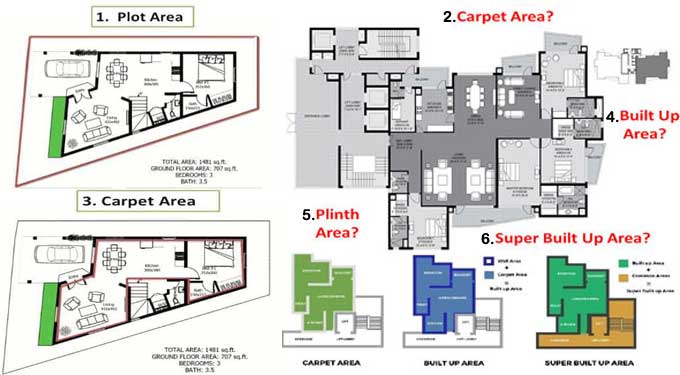
The Different Types of Area in Buildings & their Restriction

A home buyer should be aware of the plot area, built-up area, and carpet area of the property when purchasing a house. Information varies according to the area. Depending on the size of the house, you give either the carpet area or the floor area. Plot area is a term that commonly hears when purchasing land.
Types of Area in Building
Built up Area
A flat or bungalow's built-up area refers to its carpet size and wall thickness. There will also be areas where you can move about, walls, and utilities. There is usually a 10-15% difference between the carpet area and the built-up area. 50% of the wall area of your house is included in the built-up area if there is a common wall.
Carpet Area
During the carpeting process, you consider the carpet area to be the area over which you can lay the carpet. In this way, all the space available for use will show. In other words, you can define the carpet as the size of the net floor area of a bungalow or apartment.
In most real estate sectors, the authorities enforce the use of carpet areas as a measure of price for builders. Transparency in the buying and selling processes ensures uniformity, the rate base on the carpet area. So you will be certain of what you will receive.
Plot Area
Your Plot Area is the entire area between the fencing or under your ownership. Alternatively, it is known as Site Area. The purpose of fencing is usually to delineate the boundaries within your jurisdiction.
Floor Area
You can also include the basement area when calculating the floor area of the building or bungalow. A floor's area is measured both inside and outside, and the thickness of the walls also includes.
A floor area value limits the maximum number of stories that can develop on a plot of land. This value determines by the local authority. This ratio serves to limit the amount of floor space on a building. This ratio measures how much built-up area compares to how much plot area there is.
Setback Area
The setback area defines the space left on all sides of a building from the property line, where the building cannot construct. Local municipal bodies that have jurisdiction over the plot area set the limits for the setback area.
An offense commits when this law violates. It fines for not complying with the setback ordinance or even removes in the setback area. Whenever construction work falls within a setback area, a petition must submit to the local municipal authority for approval. Permission may grant if it is unavoidable and in exceptional circumstances.
Restriction Guidelines
In spite of the fact that the constructed area lies within your property, the restriction does not allow construction on the space surrounding the built-up area.
1. The foundation of the walls of the plot adjacent to the building may be overlapping with the foundation of the wall of the adjacent plot if construction reaches the wall boundaries.
2. For the foundation, the soil must be excavated. The foundation of the neighboring walls is weakened by excavation if there is not enough space left around the plot boundary.
3. Allowing the sunlight into the building benefits the residents.
4. Buildings are well ventilated because of it.
5. Buildings must be kept away from roads.
6. The vehicles move easily.
7. In order to ensure the safe placement of pipelines for water and gas supplies, as well as a waste water pipes.
Wrapping it Up
All floors include in the total floor area. An area of carpet that can spread on is the carpet area. It is the whole floor space provided for use, also known as the plinth area.
To learn more, watch the following video tutorial.
Video Source: Civil Engineer Sujit
In addition to public spaces, residents provide utilities, including playgrounds, gyms, and parks. The land between the fences is the plot area. Setting back means leaving a space around a building, which is a legal requirement.


